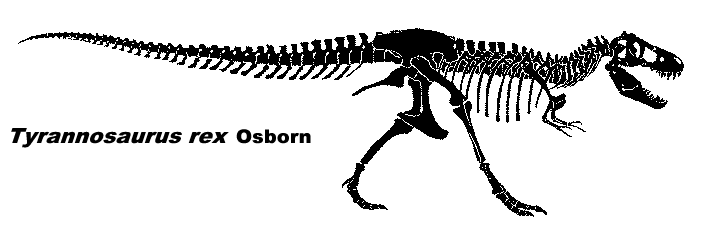
The Find
This T. rex was found in the badlands of eastern Montana by
rancher Kathy Wankel. Kathy first spotted a small piece of the shoulder
and arm weathering out of the ground. In 1990, paleontologist Jack
Horner and a crew from the Museum of the Rockies carefully removed the
overlying rock and excavated what turned out to be a nearly complete Tyrannosaurus
rex. Only a small region of the tail was missing. Kathyís
discovery was truly a spectacular find. For the first time, the complete
forearm of Tyrannosaurus was preserved, allowing estimates of its
strength and function. The pictures next to the exhibit reveal how
closely the bones were found together (articulated). When an animal
dies, the tendons in the neck shrink and the head is often "pulled" backward
toward the tail. Notice the skull lying over the hip region.
For further information, read The Complete T. rex by Jack Horner and Don Lessem.
The Mount
Each of the "bones" is a cast from the original skeleton. There
are more than 300 bones and when the casts arrived, they were in a huge
crate, unlabeled, with no instructions! The responsibility of designing
and constructing the mount belonged to Principal Museum Scientist, Mark
Goodwin. Mark assembled a talented crew of four to assist him in
the four-month
project. Each cast was hand-tooled, painted, drilled, and then
placed over an internal steel armature designed to show the skeleton in
a lifelike pose. Our T. rex is running at full speed, when
suddenly it turns its head; maybe itís dinner time!
The rex
You can print out this page and bring it with you to the Museum so
you can follow along while viewing the skeleton. Looking at the skull,
you will see that it has a high, broad face
with strutlike bones framing large openings. This pattern is characteristic
of carnivorous dinosaurs. Notice too that these bones are somewhat
loosely fit together — there is some kinesis, or "give", possible between
these bones when the animal bites down on its prey. This is important
because it appears that T. rex had great power in its jaws.
The teeth of most carnivorous dinosaurs are somewhat flattened side to
side, like daggers. They are also curved and serrated like steak
knives on their front and back edges. But in T. rex, the teeth
are not flattened side to side, although still serrated. They are
fatter, and their roots reach deep into the skull, so the whole shape is
much like a banana. Think of a mouthful of lethal bananas!
Notice how enormous the skull and legs are. The animal had
only to plant its feet and take a bite out of its prey to cause tremendous
damage. The forelimbs are very small, for reasons that are not immediately
obvious. But it seems that forelimbs were not necessary for this
animal's way of life. From years of watching monster movies on TV,
we might think that predators defend their territories against large rival
males of other species. But the image of a big T. rex fighting
a big male brontosaur or stegosaur to the death (besides being historically
inaccurate) is quite different from what happens with today's predators.
Sharks, lions, hyenas, and Komodo dragons all make their living by preying
on the sick, injured, very old, or very young members of prey species.
They tend not to wrestle healthy animals to the death, but to dart in and
inflict an injury, then retreat and watch the weakened prey until they
can strike again or the animal collapses. It is likely that T.
rex and other dinosaurian predators did the same. Like many predators,
they were probably not above scavenging fresh meat either.
We think of T. rex as being so large that it may not have
moved quickly, but it certainly seemed capable of getting up to speed in
Jurassic Park! Recently, however, scientists studied the film to
estimate the speed at T. rex was moving. They calculated that
it "maxed out" at ten to twelve miles per hour in the film — certainly not
enough to catch a fleeing Land Rover! But footprints of large carnivorous
dinosaurs suggest speeds of 20 mph or more, at least for short stretches.
T. rex was one of the last dinosaurs we find at the end of the "Age
of Dinosaurs" (along with Triceratops). It was one of the
largest known land carnivores of all time. We arenít sure why T.
rex became extinct, but we can wonder at its existence.
The T. rex skeleton is located on the ground floor of the
Valley Life Sciences Building in the circular stairwell. You get
a chance to walk up and around the largest land carnivore to have ever
roamed the planet! Stop by for a look. To learn more about
Tyrannosaurus rex, see the T. rex
exhibit. Or to learn more about other dinosaurs, see our Dinosaur
exhibit.
Directions and times for the Valley Life
Sciences Building (VLSB).

